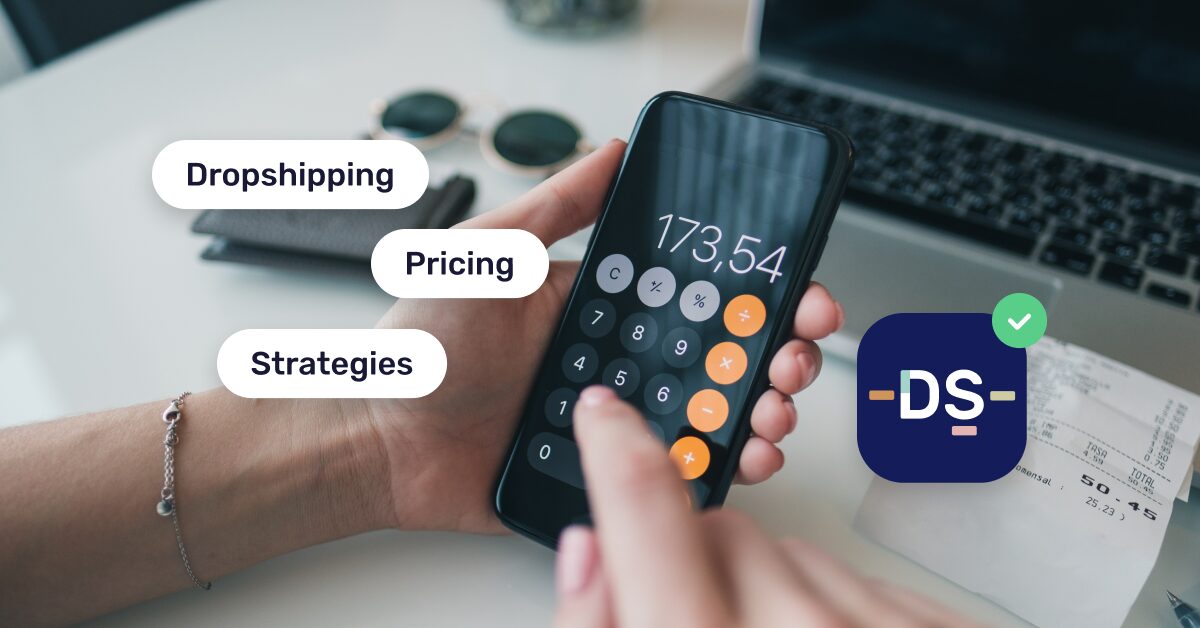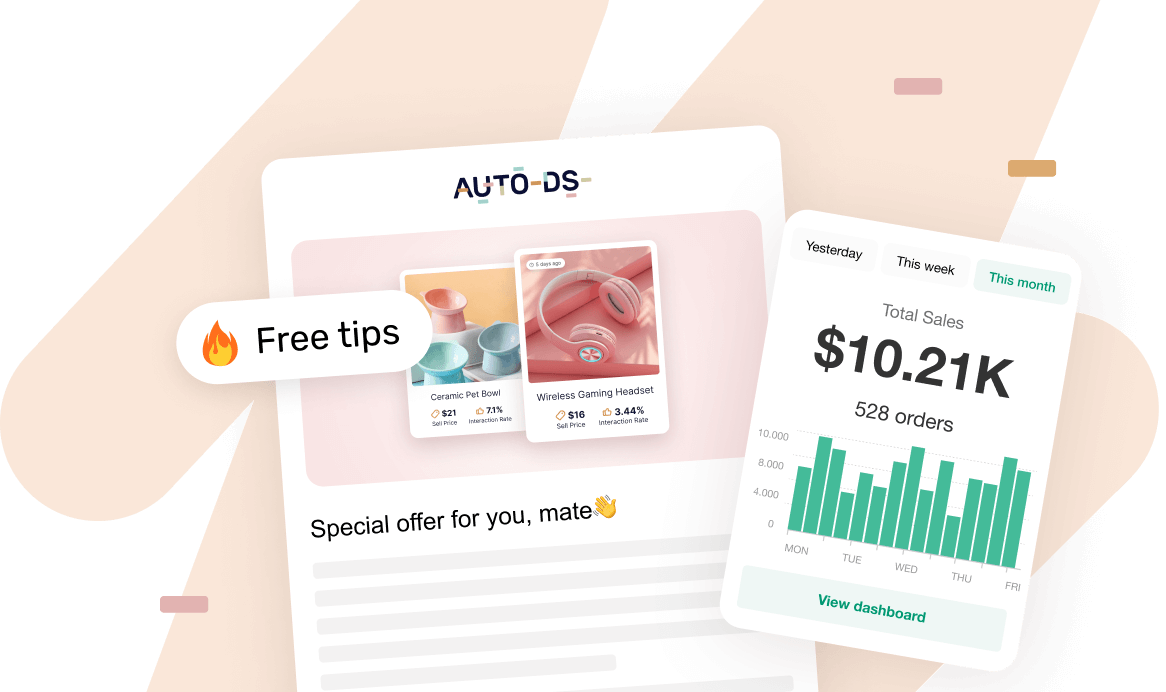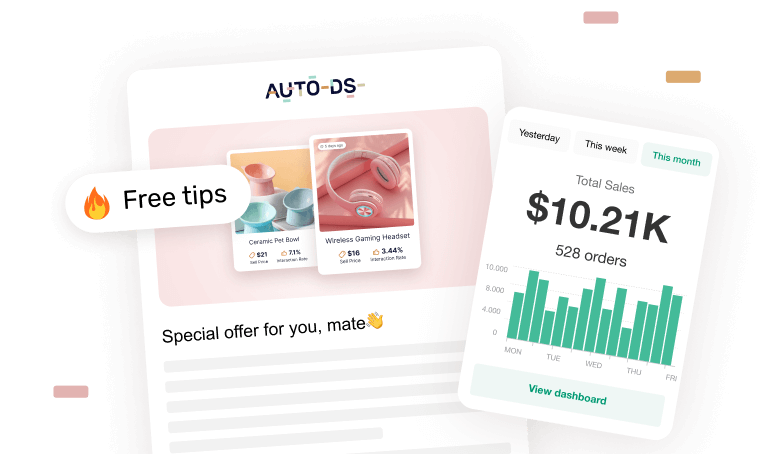Think pricing is just a boring number at the bottom of a spreadsheet? Think again. In dropshipping, your pricing strategy is just as important as fast shipping, good quality suppliers, and branding. It’s literally the secret behind your profit margins, conversion rates, and long-term growth.
Knowing how to price your products correctly is key to staying competitive and making real profits. But it’s not always straightforward. Things like supplier costs, shipping, and even warehousing can quickly complicate the math.
In this guide, we’ll break down the most effective dropshipping pricing strategies, from beginner-friendly tactics to advanced automation. Plus, we’ll show you how AutoDS simplifies pricing, automates updates, and helps you scale faster.
There’s no one-size-fits-all pricing strategy. From cost-plus to value-based and psychological pricing, your approach should depend on your product type, audience, and business goal.
Manual pricing doesn’t scale. Updating prices by hand is time-consuming, prone to errors, and makes it nearly impossible to react quickly to supplier or market changes.
Automation is the smart way forward. Tools like AutoDS let you set pricing rules, respond to product performance, and stay competitive.
The Crucial Role of Pricing in Dropshipping Success
In dropshipping, your pricing strategy does more than just influence your profits. It shapes your entire business. Compared to traditional retail, where buying in bulk and managing your own inventory gives you more flexibility, dropshipping usually comes with slimmer margins. That means every dollar counts. Think about it:
- Price too low, and you might barely break even—or worse, lose money.
- Price too high, and shoppers will likely move on to a more affordable option in seconds.
- And here’s the catch: price too low for a good quality product? This will actually come off as sketchy, so it’s not just about cutting prices.
The trick? Setting a price that is just right. An effective pricing strategy can find the balance between covering your costs and staying attractive to potential customers.
Moreover, it can influence how your brand is perceived, because pricing isn’t just about numbers. A well-priced offering builds trust, shows value, and increases conversion.
Smart pricing also gives you room to grow. It allows you to run promotions, offer free shipping, or bundle products without hurting your profits.
Bottom line? Pricing is a dynamic part of your business strategy that requires attention, testing, and sometimes automation (we’ll get into that later).
Types of Dropshipping Pricing Strategies
When it comes to pricing, there’s no magic formula. It really depends on what you’re selling, who you’re selling to, and what your goals are. Different products, seasons, and audiences call for different approaches.
Here are some of the most common pricing strategies dropshippers use, from value-driven methods to smart, psychological tactics.
Fixed Markup on Cost
This is one of the simplest and most popular pricing strategies in dropshipping. It works by adding a fixed percentage or flat dollar amount to the product costs, regardless of the item.
Let’s say your supplier price is $10, and you apply a 50% markup; you’d list the product at $15. Simple math, consistent pricing for your entire catalog.
Why it works:
- Super simple to set up and automate.
- Keeps profit margins predictable across all products.
- It’s easy to apply across large catalogs.
This one is perfect if you’ve got a big catalog and your products fall into a similar value range. It’s also a solid choice if you’re just getting started and want something that’s easy to manage and scale.
Tiered Markup on Cost
Got a diverse range of products, from low-cost to high-ticket? Then this one is for you. Instead of applying one flat markup to the entire catalog, you adjust the markup based on product cost.
Let’s see in practice: imagine you have products that range from $5 to $100. When it’s time to price them, you might double the price of the $5 product (100% markup) but only add 30% to a $100 item. This helps you avoid overpricing high-ticket products while still keeping decent margins on cheaper ones.
Why it works:
- Keeps high-ticket items competitively priced.
- Prevents overpricing low-cost items
- Offers more flexibility than a flat markup.
All in all, it’s best for stores with a wide price range of products or different profit goals across their offerings.
Cost-Plus Pricing
Cost-plus pricing is not much different from the previous ones, but adds one more layer to the math: expenses. So, how does it work? You basically calculate your total cost (including product, shipping, platform fees, and more) and then add a fixed profit margin on top.
And I know what you’re wondering: what is the average profit margin? There’s no specific answer, as it depends on your goals. An average profit margin is between 20% and 30% for most businesses, and a great profit margin is above 50%.
The formula is something like this: Product cost + Shipping + Platform fees + Profit margin = Total product price
Now, let’s do the math together: $15 + $5 + $2 = $22 + 40% profit margin = $30.80. That’s the final price of your product.
Why it works:
- Ensures you never lose money.
- Easy to calculate if you track all expenses.
- Works well with automation tools.
Ready to try it out? Try our 14-day trial for $1 and see how easy it can get with automated pricing.
Value-Based Pricing
This is where pricing gets a little more… psychological (and a lot more powerful). Instead of setting prices based on what you paid, you price based on what your customers think it’s worth.
But no worries: there’s no mind-reading involved. Here’s how it works: if your product solves a real problem, feels high-end, or taps into something your audience really cares about, they’ll often be willing to pay more, even if it didn’t initially cost much. That’s the beauty of perceived value.
That said, it does take some storytelling and strong branding to pull it off. But when done right, it can seriously boost your margins without raising your costs, especially for niche stores with unique or visually appealing products.
Remember: shoppers have to believe the product is worth the price. If they don’t see the value, they will just think it’s overpriced and head straight to the competitor with just a click.
Why it works:
- Lets you charge more for high-perceived-value products.
- Encourages premium branding and storytelling.
- Maximizes profits when executed well.
📢 Marketing Tip: Collaborate with influencers and use lifestyle photos to show the real value of your product and make it aspirational. Don’t just list features, show the outcome.
Psychological Pricing
This strategy is all about how prices feel. It isn’t just a marketing myth: humans don’t read numbers logically—we react to them emotionally. That’s why $9.99 feels like a much better deal than $10, even if the difference is tiny.
Psychological pricing can also include tactics like “limited-time discounts” or “buy one, get one for free” deals to increase urgency and appeal. It’s subtle, but incredibly effective.
Why it works:
- Proven to increase conversions.
- Makes products feel like a better deal.
- Adds emotional appeal to rational shopping.
Bundle Pricing
Trying to boost your sales? Then bundling is your best friend. It’s simple: you just group two or more products together and sell them at a slightly discounted price compared to buying each item separately. This is especially useful for stores with complementary products that can go well together.
Think starter kits, gift boxes, a summer pack (beach bag + towel), a home training set—you name it, the sky is the limit. Customers love to know they are saving money, even if it’s just cents. The result? You’ll sell more products per order, increasing revenue.
Why it works:
- Increases average order value (AOV).
- Moves inventory faster, accelerating sales.
- Appeals to customers looking for convenience and value.
Competitive Pricing
Here’s the harsh truth: the internet is a competitive place, and dropshipping is no exception. Customers are constantly comparing, looking for alternatives, and checking prices.
Competitive pricing means keeping an eye on what other stores are charging for similar products and adjusting your prices so you play the game strategically.
You can play it a few ways:
- Go lower to attract deal hunters.
- Match their prices to stay in the mix.
- Charge a little more if you’re offering something better (like free shipping, nicer packaging, or a stronger brand).
All in all, it’s all about staying visible and making sure people feel like they’re getting the best deal.
Why it works:
- Keeps you relevant in busy, competitive markets where people love to compare (like electronics, trending gadgets, or anything on Amazon).
- Appeals to price-sensitive shoppers.
- Easy to manage with price monitoring tools.
Penetration Pricing
Trying to make it into a new market? Penetration pricing is all about making a bold entrance with lower prices that grab attention, drive traffic, and help you build trust fast.
It’s a smart way to get those first sales, collect reviews, and generate some buzz. Once people start buying and loving what you’re selling, you can gradually raise your prices without scaring them off.
Why it works:
- Helps you get noticed in crowded markets.
- Kickstarts sales and builds social proof.
- Creates momentum for new products and stores.
Challenges in Manual Pricing Management
If you’ve ever tried updating prices manually, you already know: it’s not exactly fun. Sure, it might seem doable when you’ve only got a handful of products, but as your store grows, keeping track of everything quickly turns into a full-time job (with no perks). This is what usually happens:
- It’s time-consuming. I mean, just think about it: manually updating prices across dozens or hundreds of products takes forever. You’re constantly jumping between spreadsheets, supplier sites, and your store dashboard. It’s repetitive, draining, and the worst use of your time.
- It’s easy to make mistakes. When you’re handling everything by hand, the chance of making errors increases. One wrong decimal and boom, you suddenly turned a $10 item into a $100 one. You can end up overcharging customers or selling at a loss without realizing it.
- You can’t react fast enough. Prices and demand in the dropshipping world move fast. Suppliers can update their prices overnight, seasons change, holidays come and go, and a product trending today might cool off by next week. Manually adjusting prices just can’t keep up. This leads to missing opportunities or, worse, losing money every time you’re late.
AutoDS Automatic Price Optimization Feature

Manual pricing? We’ve already established that it is time-consuming, risky, and definitely not built for scale. The solution? Automation. AutoDS’s automatic price optimization feature helps dropshippers skip the manual input part and keep profits in check without lifting a finger—literally, not even a click!
This tool does the heavy lifting for you by automatically adjusting your product prices based on the rules you set. Want to make sure your margins never drop below 30%? Or that your prices automatically increase after every five sales? AutoDS handles it all, in real time, based on your strategy.

And that’s not all: the built-in price and stock monitoring tool constantly checks your suppliers for changes and updates your store in real-time. In this way, your prices are never outdated—and neither is your stock.
The benefits? Let’s see:
- Smart, rule-based pricing: You can set specific pricing rules based on your profit goals. This means defining your minimum and maximum profit margins and choosing how prices should respond to certain triggers, like sales volume or product cost changes.
- Reduced manual work and fewer errors: Relying on manual updates increases the risk of pricing mistakes, especially as your product catalog grows. Automated pricing helps streamline operations by updating prices for you, reducing the chances of human error, and freeing up time that would otherwise go into routine maintenance.
- Adapts to product performance: This tool can adjust pricing based on how individual products are performing. For example, if a product starts selling quickly, the system can gradually raise the price within your set limits. If demand drops, it can lower the price to remain competitive.
And there you have it: the power of automation. All in all, this kind of dynamic pricing helps you stay competitive without sacrificing your margins.
Ready to try it out? Try our 14-day trial for $1 and see how easy it can get with automated pricing.
Frequently Asked Questions
How does AutoDS charge you for its services?
AutoDS pricing depends on the monthly plan you choose. Each one varies depending on the number of products, stores, and features you need, with optional add-ons for automation tools, order fulfillment, and marketplace integrations. You can also get discounts by opting for annual billing. No hidden fees, everything is clearly laid out at checkout.
Can AutoDS help automate dropshipping pricing strategies?
Yes, AutoDS offers advanced pricing automation features. You can set your own rules to automatically update prices based on things like supplier changes, profit margins, break-even points, and more. It’s a simple way to keep your prices competitive and profitable without having to update everything by hand.
What is the best pricing strategy for new dropshippers?
For beginners, a cost-plus pricing strategy is often the easiest way to go. You just add a fixed percentage on top of your product cost—it’s simple and gets the job done. Once you gain experience, you can start exploring more advanced strategies like value-based or tiered pricing to optimize profits.
How do I stay competitive with my dropshipping prices?
To stay competitive, keep an eye on what your competitors are doing, use dynamic pricing tools, and automate price updates using software like AutoDS. You can also mix in smart tactics like bundle deals, limited-time discounts, and psychological pricing tricks to catch attention while maintaining healthy margins.
How can I configure preferred pricing settings in AutoDS?
To set your preferred pricing, go to Settings > Business Policies > Pricing in your AutoDS account. There, you can customize your profit margins, break-even points, and add automation rules for price adjustments based on supplier changes. These settings will automatically apply to all your future product imports.
Master Your Dropshipping Pricing Strategy
Pricing might seem like just another task on your list. But as we’ve seen, it’s so much more than just picking a number. When used strategically, it’s one of the smartest tools you have for increasing your profit margins and growing your store.
The good news? You don’t have to do it manually. AutoDS automates your pricing, protects your margins, and helps you stay competitive—without spreadsheet headaches.
Test, tweak, and let automation do the heavy lifting for you. Ready to price like a pro? You’ve got this.
And, if you want to keep learning about dropshipping, here are a few articles you can check out:
















